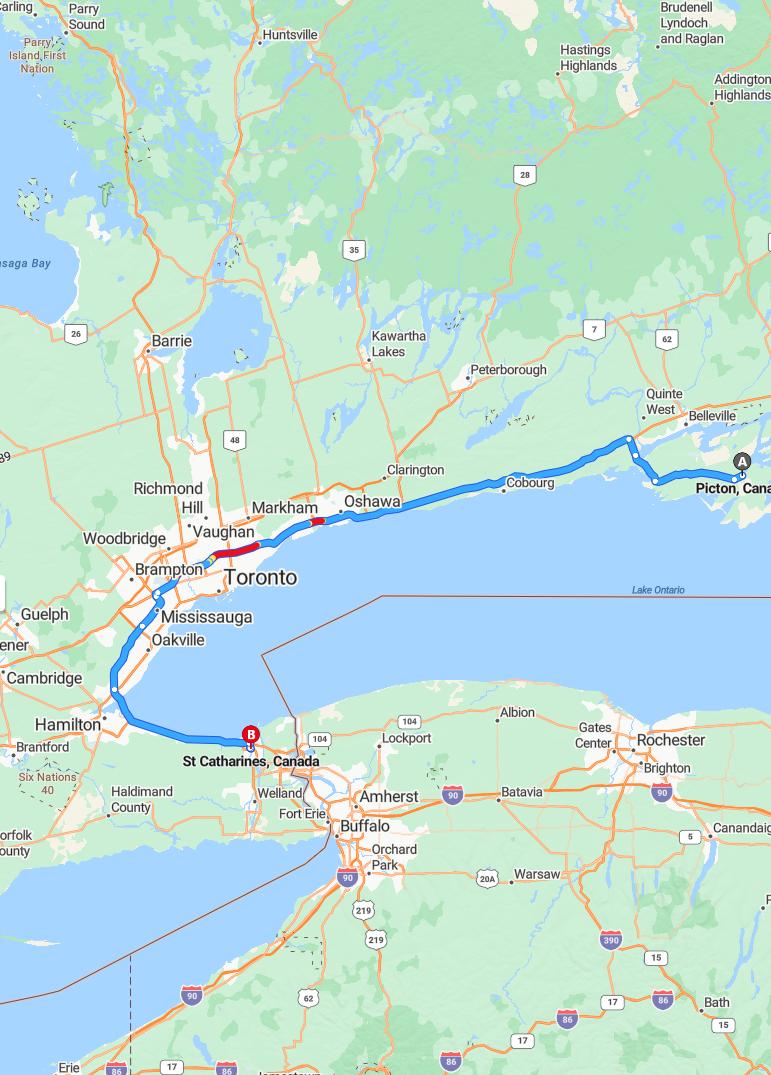Distance and estimated driving time
The drive from Picton to St. Catharines covers approximately 201 miles and takes around 3 hours and 41 minutes, making it a manageable journey across southern Ontario. Travelers will primarily use the ON-401 W and Queen Elizabeth Way (QEW) highways, ensuring a smooth and direct route. Planning ahead for potential traffic on these busy highways can help ensure timely arrival. Overall, this route offers a scenic drive through the Heartland region, connecting two vibrant communities efficiently.
Driving route
The scenic drive from Picton to St. Catharines takes travelers through a diverse cross-section of Ontario's key cities and regions. Beginning in Picton, the route heads southeast towards Cobourg, offering picturesque views of Lake Ontario's shoreline, before passing through the bustling cities of Oshawa and Markham. As the journey progresses, travelers experience the vibrant urban environments of Vaughan, Brampton, and Toronto, with ample opportunities for sightseeing and cultural exploration. Continuing westward, the route traverses Mississauga, Oakville, and Hamilton, each known for their unique local attractions and scenic landscapes. Finally, the drive culminates in the charming city of St. Catharines, renowned for its vineyards and lakeside views, providing a memorable end to this comprehensive Ontario road trip.

Key landmarks along the route
Traveling from Picton to St. Catharines, drivers can enjoy a scenic journey rich in landmarks and attractions. Starting in Picton, travelers can appreciate the stunning views of Prince Edward County's vineyards and waterfront parks. As they pass through Toronto, the iconic CN Tower and the Rogers Centre stand out as must-see attractions. Continuing through Oakville and Hamilton, visitors have the opportunity to explore historic downtowns and waterfronts, culminating in St. Catharines' beautiful Welland Canal, a marvel of engineering and a symbol of the region's industrial heritage.
Traffic conditions and peak hours
Traveling from Picton to St. Catharines, drivers should expect varying traffic conditions, with peak hours typically occurring during weekday mornings from 7:00 AM to 9:00 AM and in the late afternoon from 4:00 PM to 6:00 PM. Major urban centers such as Toronto, Mississauga, and Vaughan often experience significant congestion during these times, especially on key routes like Highway 401 and Queen Elizabeth Way. Midday and late evening hours generally see lighter traffic, making for smoother travel through the region. To avoid delays, it is advisable to plan travel outside of peak hours and stay updated on real-time traffic reports along the route.
Recommended rest stops and amenities
When driving from Picton to St. Catharines, it's advisable to take convenient rest stops along the route to ensure a comfortable journey. Cobourg offers several cafes and parks ideal for short breaks, providing a scenic and relaxing environment. In Oshawa and Markham, travelers can enjoy numerous amenities such as gas stations, fast-food outlets, and shopping centers to refuel and refresh. As you approach the Toronto area, numerous rest areas with seating and restrooms are available, making it easy to pause before continuing on toward your final destination.
Weather forecast for the travel day
The weather forecast for the travel day from Picton to St. Catharines indicates mostly mild and clear conditions, making for a smooth journey. Travelers can expect sunny skies with minimal chances of rain, especially in the earlier parts of the trip through Picton, Cobourg, and Oshawa. As you approach the Greater Toronto Area, including Markham, Vaughan, and Brampton, the forecast remains favorable with light breezes and comfortable temperatures. Overall, it should be a pleasant day for driving, although staying updated on local conditions is advisable for any sudden weather changes along the route.
Vehicle preparation tips for the trip
Before embarking on your drive from Picton to St. Catharines, ensure your vehicle is thoroughly prepared for the journey. Check the tire pressure and tread, and top off all fluid levels, including oil, coolant, and windshield washer fluid. Inspect your brakes, lights, and mirrors to ensure they are functioning properly for safety and visibility. Finally, pack an emergency kit with essentials such as a first aid kit, roadside assistance contacts, snacks, and water to stay ready for any unforeseen situations along the route.
scenic spots to visit en route
During your drive from Picton to St. Catharines, you'll encounter several scenic spots worth exploring. In Cobourg, relax at the picturesque Cobourg Beach and stroll along the historic downtown waterfront. As you pass through Oshawa and Markham, visit Rouge National Urban Park for lush landscapes and outdoor activities, offering a peaceful escape from city life. Approaching Hamilton, be sure to stop at the Royal Botanical Gardens, renowned for its stunning gardens and natural beauty, before reaching your final destination in St. Catharines.
Safety tips for highway driving
When driving on highway routes such as from Picton to St. Catharines, safety should always be a top priority. Ensure your vehicle is well-maintained, with functioning brakes and tires, before embarking on your journey. Stay alert by avoiding distractions like mobile phones and keeping your focus on the road, especially in busy areas like Toronto and Mississauga. Additionally, adhere to speed limits and maintain a safe following distance to prevent accidents and ensure a smooth trip through all the en route cities.
Alternative routes and detours
Travelers driving from Picton to St. Catharines can consider alternative routes and detours to avoid traffic congestion or roadwork. One option is to take the Highway 401 westbound earlier to bypass Toronto's downtown core, connecting through the 403 to reach St. Catharines more efficiently. Alternatively, drivers can use Highway 7 through the York Region, then connect to Highway 404 south, which offers a less crowded route around the Greater Toronto Area. Planning ahead with real-time traffic updates can help identify unexpected delays on main routes and provide suitable detour options, ensuring a smoother journey.
